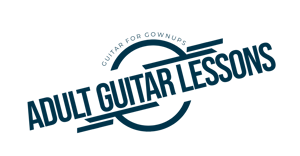If you play electric guitar or acoustic electric guitar, you will surely be shopping for cables.
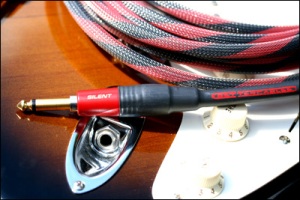
As you have probably noticed, guitar cables can be found in many different lengths and styles. Here are some ins and outs about guitar cables.
In order to get a good, clean connection between your guitar and amp you want to use a “guitar” cable. This is a shielded cable that is specially designed to work with you guitar and amp. Don’t use speaker cables or zip wire, these will create unwanted line noise.

Most guitar cables are purchased according to their length, and can vary in price according to the hardware used for the connectors, and the type of exterior material.
For guitar and amp applications the guitar cable will have 1/4″ male mono jacks on either end, and braided shielding inside the jacket to help reduce noise interference.
If you purchased a new electric or acoustic electric guitar you may have received a guitar cable with it. If so, it is probably a fairly thin bodied cable in the 10′ range. The first thing you should do is throw that out! Or, at best, stick it on the closet shelf for an extreme emergency. These cables
have a very short life expectancy.
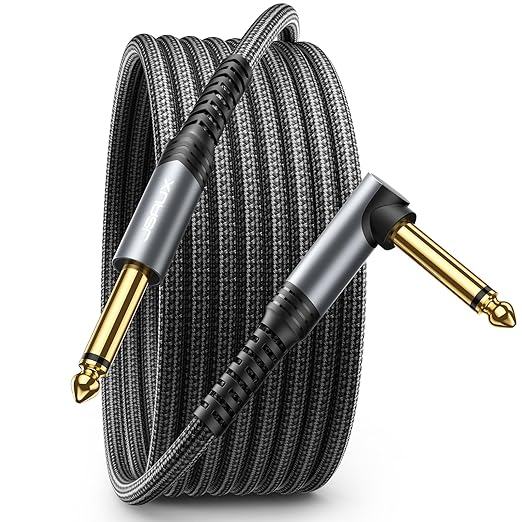
Shop Guitar Cables on Amazon

Cable Length
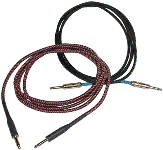
When buying a cable you will want to determine the best length for your situation. Too long, and you wind up tripping over excess cable – too short, and you can’t reach your amp.
For my current set up, I have an electric guitar with a multi effects processor so I use two guitar cables. One from my guitar to the processor, and one from the processor to the amplifier.
For the cable that goes from my guitar to the processor, which sits directly in front of me on stage, I use a 10′ cable. That gives me plenty of room to move on stage without a lot of excess getting tangled up around my feet.
For the cable from my processor to my amp, I use an 18′ cable. This gives me some extra length to work with. I never know, from venue to venue, what type of stage setup will be available, so for the most part, 18′ seems to cover just about any circumstance.
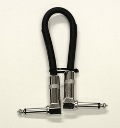
Of course, your situation may be completely different. Try to anticipate where you will be setting your rig up and have cables ready for anything that may come up.
If you play through effects pedals and have two or more on the floor in front of you, there are small cables made to connect those pedals. They come in lengths of a few inches or less.
Fender Deluxe Series Instrument Cable, Guitar Cable, Guitar Accessories, Straight/Straight, Tweed, 10ft
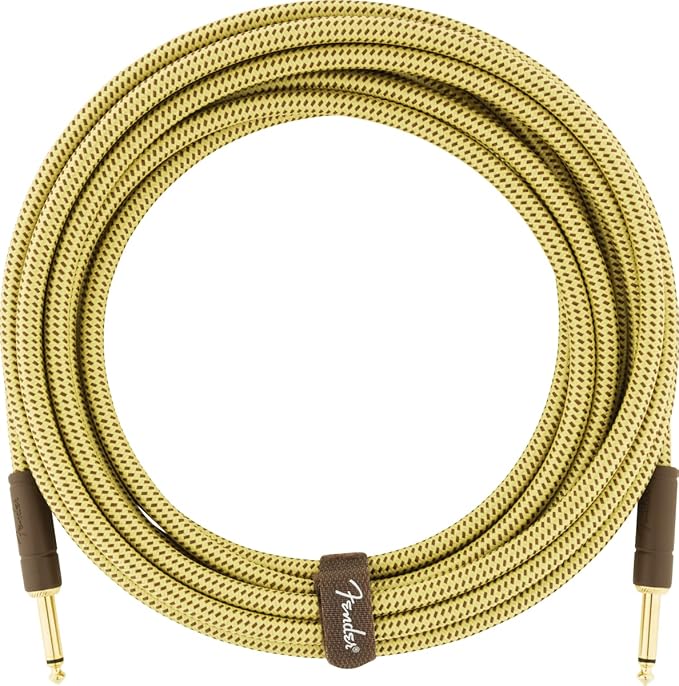

Cable Pricing
You can find a good 10′ guitar cable from a reputable manufacturer for under $10. Of course, as the length increases so does the price.
There are several companies that produce more expensive guitar cables. The higher price is based on materials used in manufacturing the cable. Most claim a noticeable improvement in sound and noise reduction.
There are a number of cosmetic differences in cables such as color and jacket material. All are in various price ranges. The upper end “boutique” cables can go for $40 or more.
Angled vs Straight
Most guitar cables are available with either straight plugs or right angle plugs (or one of each).

You will want to consider your personal setup when considering whether to purchase cables with right angle or straight plugs.
If you have an electric guitar with the input jack on the outside part of the body, similar to a Les Paul, you may want to choose a cable with at least one right angle plug. This will keep the cable end more flush with the body of the guitar and cut down on the accidental impact that is common when using a straight plug on these types of guitars.
Most acoustic electric guitars would fall into this same category.
If your guitar has the input jack on the front of the body, similar to a Strat, then a straight plug will be more suitable due to the input insertion angle.
Once you determine the best angle position for the “guitar end” of your cable, you will want to decide what will be the best position for the other end.
If you are plugging into an effects pedal that has its input on the right side of the pedal, you may consider using a right angle plug, because a straight plug invites the possibility of someone stepping on it.
If you are plugging directly into your amplifier then a straight plug should work well because it will allow the cable to extend straight out to you without having to make any turns, which could cause undue stress to the cable.
Mogami Gold INSTRUMENT-06RR Guitar Instrument Cable, 1/4″ TS Male Plugs, Gold Contacts, Right Angle Connectors, 6 Foot


“Strap it Down”

Either way, a good habit to get in to when hooking up the “guitar end” of your cable, is to run it underneath your guitar strap from behind, and then into the guitar strap. This secures the cable in place and prevents accidentally stepping on the cable and pulling it out of the guitar input while playing.
Regardless of which cable you choose, always try to bite the bullet and have an extra one with you as a spare. Guitar cables have a funny way of going out at the most inopportune moments!
Please do not hesitate to contact us with any questions!
